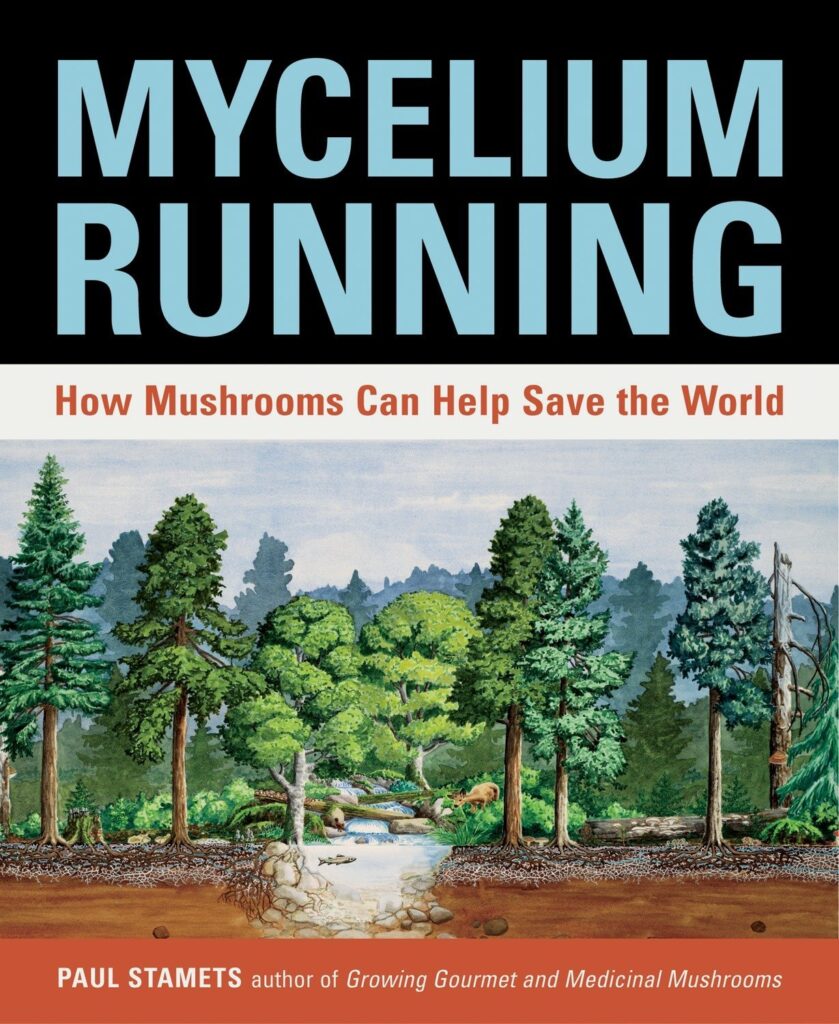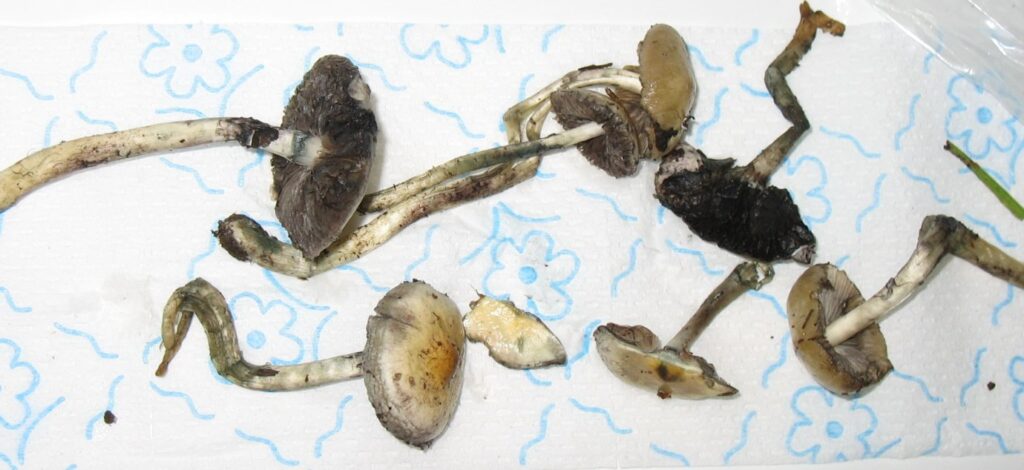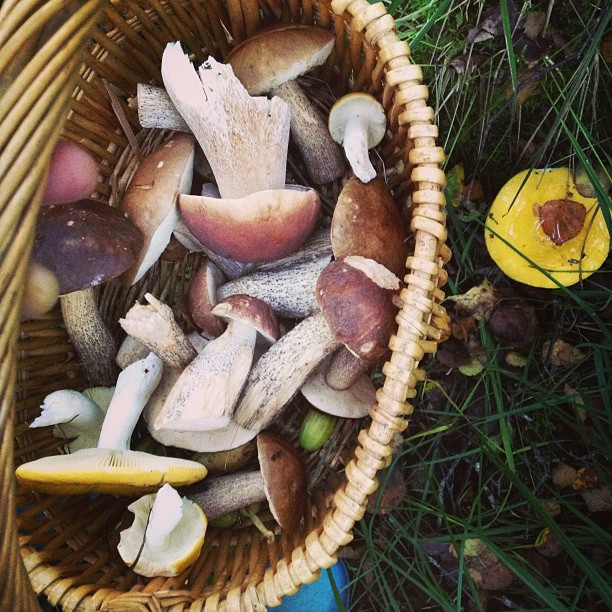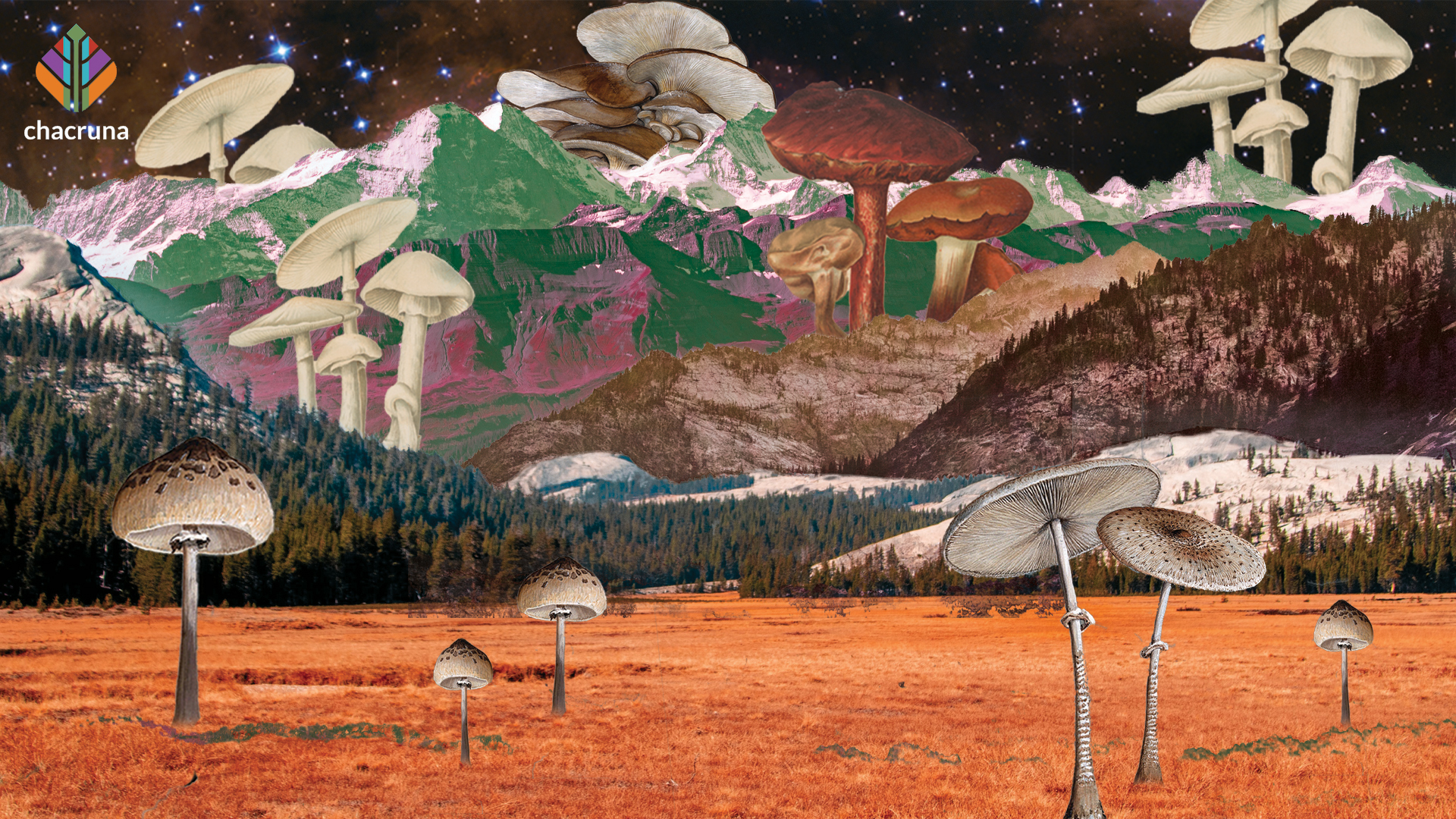- DIY Mycology in a Psychedelic World - December 22, 2021
When I asked Ben how he got interested in mycology, he explained he had been on a road trip in California when he stopped at a roadside cafe and saw a book called Mycelium Running on the bookshelf. “The subtitle said ‘How Mushrooms Can Help Save the World.’ I flipped through all the pages and I was mesmerized by the pictures and all the information in it. … I’ve read it four or five times [since then].”
The book is by the mycologist and businessman Paul Stamets, best known for two canonical mushroom cultivation manuals, published in 1983 and 1993, respectively. Mycelium Running (2005) is an unusual mix of mystical prose, dry scientific explanation, and practical instruction. Alongside descriptions of practical applications for fungi, the book is known for its epic opening chapters that offer a myco-centric history of life on Earth, reflections on the “mycelial archetype” (i.e., network and spiral formations), and philosophical proposals about the sentience and benevolence of fungi. The book has an evangelical quality, sometimes lapsing into what seem like religious testimonials. Overall, it offers a profoundly ecological vision of our connection with the living world, as well as a compelling argument for fungal consciousness, all within what appears to be a scientific framework.

Ben’s chance encounter with Mycelium Running intensified an already dormant fascination with fungi. His first introduction to mushrooms had been a few years earlier when, as a college student in Northern California, he began to grow psychedelic mushrooms for himself and his friends, learning from online forums and websites. I met Ben during my fieldwork from 2014 to 2017 with a loose network of groups teaching community-driven applied mycology. He was one of the co-founders of the Fungal Alliance of the Bay (FAB), which taught mushroom cultivation and mycological applications for ecological restoration, like myco-remediation (the bioremediation of toxins with fungi). (FAB is a pseudonym, as are all the names of individuals quoted in this article.) The goal of FAB was to give people practical knowledge to grow mushrooms for food and medicine, to inspire them to experiment with accessible (ideally, cheap and easy) applications for fungi, and to create community to make these collective projects possible.
When I began fieldwork, this kind of lo-tech applied mycology was becoming more common among naturalists, self-described citizen scientists, biohackers, permaculturalists, and others working at the intersection between ecology and lo-tech science. Similar groups—loose-knit and collectively run, dedicated to informal education and accessibility, motivated by enthusiasm for the fungal kingdom, and inspired by Mycelium Running—had sprouted up around the US and Canada. The first Radical Mycology Convergence, something like a cross between a conference, a festival, and a campout, had taken place in 2012. Since then, this phenomenon has grown. (See Doug Bierend’s book, In Search of Mycotopia, for an up-to-date overview of this scene.) There’s still no set term for this emerging movement, nor its makeshift technological practices, nor its unique scientific subculture. Some people called it “radical mycology” (after a zine, and then book, by Peter McCoy) or simply “applied mycology.” I decided to call it “DIY (do-it-yourself) mycology.”
Early on, I began to wonder if psilocybin mushrooms were something like “the gateway mushroom”: one day you decide to grow magic mushrooms and the next thing you know, you’re ordering live meal worms online to feed your Cordyceps culture.
Ever since I began fieldwork, I was curious how psychedelics fit into the world of DIY mycology. It was easy to spot the psilocybin mushrooms in people’s stories of mycological fascination, especially among public figures like Paul Stamets. Then there was the fact that Mycelium Running, the book that inspired this movement, felt undeniably “psychedelic.” Early on, I began to wonder if psilocybin mushrooms were something like “the gateway mushroom”: one day you decide to grow magic mushrooms and the next thing you know, you’re ordering live meal worms online to feed your Cordyceps culture. In other words, it’s a slippery slope from mycological “noob” (newbie, in cultivator slang) to the person spouting Latin binomials and waxing poetic about hyphal growth patterns.
And, indeed, several people in the DIY mycology scene (as well as many small-scale mushroom farmers I met) first learned to cultivate mushrooms by growing Psilocybe cubensis, the most well-known and easy to cultivate psychedelic mushroom. That said, this was not true for all, and their relationships to psychedelic mushrooms were diverse. Some had tried the mushrooms just once or twice, while others had long histories of use; some saw them as purely recreational, while others used them for explicitly spiritual or therapeutic purposes (or both). A couple were unequivocally dismissive of the idea there was any truth to be gained by the psychedelic experience; as one FABer put it, the mushrooms just “confuse the brain” (but, he added later, they are good for treating depression). There were also a few people I interviewed that had never consumed psychedelic mushrooms. Differences aside, everyone I spoke to was gleeful that such mushrooms existed. They loved to joke about them and the altered states they engendered, as much as they loved to regale each other with stories of the gourmet wild mushrooms they found on their latest forays.

This heterogeneity was curious to me because it belied a common gloss of this narrative: that the gateway to mycological fascination was the consumption of psychedelic mushrooms. In other words, that the psychedelic experience itself catalyzed this subjective orientation. This story had precedents in Stamets, who alluded often in talks (several of which are on YouTube) to learning all kinds of things, both technical and spiritual, from psilocybin mushrooms; and in Terence McKenna, who elaborated fantastically on transmissions from “the mushroom” in his famous lectures; but it also goes back further to the earlier days of American psychedelia when LSD and psilocybin were championed as a form of religious communion and tools for revelation and liberation—that is, as drugs that opened up a particular kind of knowledge, philosophical outlook, or enthusiasm. The gateway mushroom story struck me as a myth in the sense Roland Barthes used the term: as a kind of cultural shorthand, an easily understood, appealing, and deceptively coherent thumbnail sketch that simplifies complex, ambiguous, and often contradictory processes—in this case, how psychedelics come to generate particular meanings in a culture.
Historians have written about the myriad ways that LSD and psilocybin were used in this period: as aids to dropping into one’s body, tuning into the universe, becoming one with nature, finding one’s authentic self, realizing one’s true potential, or tackling complex problems.
This seemed especially salient in the context of DIY mycology because, while it may not be true for everyone’s individual trajectories, psilocybin-active fungi were definitely a catalyst in the history of this unique scientific subculture. As is well-known, psychedelics are interwoven with the regional history of the Bay Area, California, and the American West since at least the 1960s. They were integral to the rise of the environmental movement and the ecological lifestyles that grew out of the counterculture of that time. Stamets’s own career is intertwined with this ecological counterculture as it evolved over the last four decades. His cultivation manuals, and later Mycelium Running, were part of a new literary genre that followed in the wake of the phenomenal success of The Whole Earth Catalog in the 1970s, which catered to (and helped create) a new environmentally conscious milieu. During this time, Americans sought new ways to live, especially in relation to the natural world and their own bodies. They bought cookbooks, “lifestyle” books, and instructional manuals—for everything from sex, to cheese making, to home births, to (yes) mushroom cultivation—to help them become more “natural,” “authentic,” and “holistic,” and to learn practical (and profitable) skills for ecological living (Belasco, 2007; Binkley, 2007; Kirk, 2007). Historians have written about the myriad ways that LSD and psilocybin were used in this period: as aids to dropping into one’s body, tuning into the universe, becoming one with nature, finding one’s authentic self, realizing one’s true potential, or tackling complex problems (Kripal, 2007; Markoff, 2005; Turner, 2006). The 1970s through the 2000s saw the back-to-the-land movement, the success of the organic food movement, the popularization of natural and alternative medicine, and the continued (albeit underground) use of psychedelics, all of which dovetailed with the tectonic shift away from institutionalized religion, towards secular and “spiritual” identities.
Join us for our next conference!
The technical practice of DIY mycology is also rooted in psychedelia. The idea of “tinkering” with fungi originated in the novice experimentations of psychedelic enthusiasts in the 1970s, which flourished online in the 1990s. A number of ingenious, jury-rigged techniques for growing Psilocybe species came out of the peer-to-peer forums on Reddit, Shroomery, and Mycotopia (as I’ve written about elsewhere). These websites epitomize the peculiar mix of obscure expertise and populist accessibility that characterizes DIY mycology. This ethos of openness and accessibility can be traced back to this close kinship of countercultural ecology with the open-source movements of the 1980s and 1990s in the early days of the Internet.
The ecological counterculture had far-reaching effects in American culture, society, and economy.
The ecological counterculture had far-reaching effects in American culture, society, and economy. This was the “archeology of the present” of my fieldwork. It could be seen in my interlocutors’ values and the paths they chose. It shaped their vocations, hobbies, politics, morality, and aesthetics—and my own. So, was it surprising that psychedelics were still a common presence in their social and cultural worlds? That said, these were not the psychedelics of the earlier period, coded as necessarily transformative, as a singular access point to knowledge or spirituality. Rather, psilocybin was only indirectly related to the wonder and reverence DIY mycologists felt for the fungal kingdom.
For example, Oscar, in his late-20s at the time, grew up foraging for chanterelles with his “foodie” parents in Northern California before becoming an experimental filmmaker and permaculture gardener. He told me that psychedelics shaped how he related to mushrooms only in that they helped him understand “that mycelium is a fractal.”
He continued, “Honestly, it’s just food. Like, the psychedelic part was definitely a big part of shaping who I am and the path I chose, but what really kept me with mushrooms is that I’m a food person. And I really liked foraging…The thing about mushroom foraging is that it keys you into the landscape in a way that other things don’t.… So, through my desire to get a bunch of porcinis [laughing], I had to figure out what makes a porcini—which is a complicated set of variables.”
As for psychedelics being “a big part” in shaping Oscar’s path, he told me that he saw them as a means to produce a spiritual experience, which was an innate propensity of human brains. He explained that when he had a spiritual experience using psychedelics, he understood that “all organisms are valid and alive and interconnected. And we all share life together. None of us exists in any separate bubble. There is no ‘me’ without the ecosystem. There is no ‘me’ without trees, or bacteria, or mountains and rivers, and there’s no ‘me’ without the entire… framework.”
Towards the end of the interview, when I asked Oscar how he would describe himself in terms of religion, he thought for a second and then said, “Like, ‘psychedelic naturalist’… I feel at peace and connected, and like I’m whole, when we go to the woods.”

In some ways, Oscar’s story illustrates the quintessential psychedelic experience and its ideal (or mythic) aftermath, but at the same time, his story reveals discontinuities with the cultural myth. While he attributes a relational, biocentric understanding to his psychedelic experiences, it was fungi themselves, in their vital particularity, and foraging for mushrooms in particular, that capture his attention. Foraging (as well as working with plants) allows Oscar to channel his ecological awareness into a pragmatic activity. Plus, foraging draws him into the forest, where he finds spiritual sustenance.
Fred, a permaculturalist in his mid-20s, had a similar story. He referred to himself as “spiritual,” which he described as “an understanding that I’m connected to everything. … Like, I’m microorganism living in the earth like there’s gut bacteria inside of me.” When I asked him if mushrooms (broadly speaking) played a role in his spirituality, he told me he used psychedelic mushrooms to cure a chronic twitch and quit smoking, and then added, “And foraging, it’s an amazing thing. It’s just a really deep connection. I mean that’s spirituality to me in a nutshell: it’s connection.”
‘Connection’: if there’s one word that sums up the cultural significance of psilocybin, perhaps it is this. “Connection” resonates profoundly with the emergent significance of fungi too—the actual physical form of mycelium is, quite literally, a living and interstitial web.
“Connection”: if there’s one word that sums up the cultural significance of psilocybin, perhaps it is this. “Connection” resonates profoundly with the emergent significance of fungi too—the actual physical form of mycelium is, quite literally, a living and interstitial web. As affecting and profound this resonance may be, when Oscar and Fred spoke about the enchantments of the fungal kingdom, it was not psilocybin they mentioned but foraging, as well as simply observing and learning about fungal life. This sentiment was common among DIY mycologists of all generations. Stamets himself described the old growth forests of Washington as his and his wife’s “church” (Stamets, 2008). As an activity, foraging is mentally focused and pragmatic. It calls for attention and attunement to that “complicated set of variables” (as Oscar put it) that allow fungi to thrive. Anthropologist Anna Tsing calls this aspect of mushroom hunting “the arts of noticing” (Tsing, 2015). It enacts a kind of purposeful relationality to nonhuman life.
In his ethnography of psychedelic researchers, Nicolas Langlitz describes a form of “biomysticism” that is compatible with modern science and that takes as “its spiritual focal point … not the extraordinary mental states engendered by hallucinogenic drugs but rather the ordinary existence to which the self-experimenter eventually returns” (Langlitz, 2012, p. 110). This rings true for DIY mycology as well. The “extraordinary mental states” of psilocybin were not the focal point of their fascination with fungi, even if they were historically significant to the cultural and technical evolution of the practice. Rather, many of the people I met regarded psilocybin as just one among many of the myriad mind-blowing elements of the fungal kingdom. As Fred put it, “Understanding that there is such a thing as a psychedelic mushroom is kind of a cornerstone to the unbelievable nature of mushrooms and fungus in general. I mean, if you don’t know anything about them, you at least know that they can kill you or make you trip balls [laughing]. You know?” Psilocybin was just another dimension of the sometimes unnerving, transformative power of fungi.
The “extraordinary mental states” of psilocybin were not the focal point of their fascination with fungi, even if they were historically significant to the cultural and technical evolution of the practice.
From an historical perspective, psychedelic mushrooms were gradually encompassed by an array of engagements with the fungal kingdom, some of them relatively new in human history, others truly ancient. And, much more broadly, psychedelics were encompassed by an ever-growing range of ecological practices that fuse ecology-as-spirituality with ecology-as-scientific-discipline. Psychedelics are no longer a privileged pathway into this particular kind of spirituality—even when this spirituality seems uniquely “psychedelic.” Today, all of these practices—psychedelics, foraging, sustainable food systems, and others—coexist in a web of proximate cultural possibilities in which DIY mycologists live and move. These practices were not linear; in other words, psilocybin mushrooms did not necessarily inspire people to engage with the fungal kingdom, and if people espoused a spirituality of connection, it was often enacted through, and infused, all of these activities and interests. Psychoactive Psilocybes might be one “gateway mushroom,” but so are porcini, cordyceps, Amanita muscaria, lion’s mane, shiitake, and reishi. The “drug” here is not psilocybin but curiosity and captivation with fungal life.

Discover the Indigenous Reciprocity Initiative of the Americas
References
Belasco, W. (2007). Appetite for change: How the counterculture took on the food industry. Cornell University Press.
Binkley, S. (2007). Getting loose: Lifestyle consumption in the 1970s. Duke University Press.
Kirk, A. (2007). Counterculture green: The Whole Earth Catalog and American environmentalism. University Press of Kansas.
Kripal, J. (2007). Esalen: America and the religion of no religion. University of Chicago Press.
Langlitz, N. (2012). Neuropsychedelia: The revival of hallucinogen research since the decade of the brain. University of California Press.
Stamets, P. (2005). Mycelium running: How mushrooms can help save the world. Ten Speed Press.
Stamets, P. (2008, March). 6 ways mushrooms can save the world [Video file]. https://www.ted.com/talks/paul_stamets_on_6_ways_mushrooms_can_save_the_world.
Tsing, A. L. (2015). The mushroom at the end of the world: On the possibility of life in capitalist ruins. Princeton University Press.
Turner, F. (2006). From counterculture to cyberculture: Stewart Brand, the Whole Earth Network, and the rise of digital utopianism. University of Chicago Press.
Art by Trey Brasher.
Take a minute to browse our stock:
Did you enjoy reading this article?
Please support Chacruna's work by donating to us. We are an independent organization and we offer free education and advocacy for psychedelic plant medicines. We are a team of dedicated volunteers!
Can you help Chacruna advance cultural understanding around these substances?
















